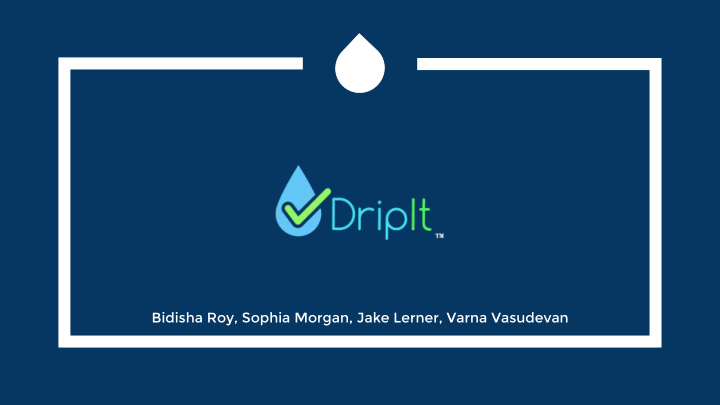



Bidisha Roy, Sophia Morgan, Jake Lerner, Varna Vasudevan
PROMPT Design a solution that will allow the Berkeley community to solve some aspect of the California drought.
OVERVIEW 1. Problem 2. Journey 3. Final Design 4. Further Work
1 PROBLEM
QUESTION ? “How is most of California’s available water consumed?”
EMILY “I don’t know.”
BEHNAZ “Daily use. People waste water by taking showers that are too long.”
“ “Approximately nine million acres of farmland in California are irrigated, representing roughly 80% of all human water use.” - Public Policy Institute of California
ANSWER Most water usage is invisible to consumers! Household Use Agricultural Use Gallons Gallons 10 Minute Shower ~20 Slice of Cheese Pizza 155 20-40 125 Washing Machine Bean Burrito Flushing Toilet 1-3 Beef Burrito 425
PROBLEM ! People don’t know this.
QUESTION ? “How many of gallons of water do you think it takes to prepare one pound of beef?”
ANSWER 1800 gallons of water
PROBLEM drought awareness ignorance of consumption no policy data no policy drive misinformed cutbacks
real-time visual indication of water consumption
SOLUTION A versatile “water footprint” monitor to be deployed in UC Berkeley Residence Halls and Dining Facilities.
2 JOURNEY
QUESTION “How is most of California’s available water consumed?”
IDEATION
IDEATION dorm smart program to policy make it change sustainable ideas water visual usage indicator tracking technology
INSPIRATION
INITIAL DESIGNS
3 FINAL DESIGN
FUSION 360
“
FEATURES display of individual and aggregate use
FEATURES configured to off-the-shelf sensors
PARTICIPATION ■ Sensor Technology ○ Humidity Sensors ○ Flow Sensors ○ Temperature Sensors ○ IR Sensors ■ Different sensors for different applications
FEATURES cloud: stores data, aggregates it, and provides usage rates
CLOUD 4. DripIt pulls usage/increment cloud. 5. DripIt pushes usage Increments data to cloud. 3. Server calculates usage automatically. per serving or second 1.DripIt labelled in cloud, ie ‘Dessert Box’ 6. Aggregated data 2. Staff sync available for DripIt to menu organization item or appliance
STAKEHOLDERS UC Berkeley ■ GOAL: “Reduce potable water ○ use to 10% below 2008 levels by 2020” Measures primary water ○ use, but not secondary water use Students are unaware of ○ Berkeley’s “Water Action Plan” (Source: http://sustainability.berkeley.edu/water)
STAKEHOLDERS ■ Berkeley Students ○ Need information to make personal choices and drive policy reform. ○ Need to see personal usage footprint, whether or not they care enough to look it up online or via an app.
IMPLEMENTATION
IMPLEMENTATION DripIt sensor
STAKEHOLDERS ■ Dining Hall Staff ○ Responsible for setting ‘per serving’ usage in dining halls. ○ Usage must be quick and not require calculations or calibration.
IMPLEMENTATION DripIt
STAKEHOLDERS ■ Residence Hall Staff (Adults) ○ Responsible for placing product in dorms. Usage must be quick and not require ○ calculations or calibration (ResComp) ■ Residential Advisors (Upperclassmen) Initiate inter-floor competitions ○ ○ Floor meetings ■ Residential Hall Associations (Peers) Initiative to promote water conservation ○ ○ Committee meetings can relay feedback
WHY DripIt ability to real-time connect to a visual variety of indication of sensors yields water many consumption applications in the physical space, no one can hide
IMPACT data awareness change
4 FURTHER WORK
POLICY DripIt can influence policy: ○ Meatless Mondays ○ Low-water meals ○ Dorm floor competitions
EXPANSION DripIt in other places: ○ Rest of campus ○ Other universities STARTING HERE! ○ Other organizations
CONCLUSION passive. personal. present.
Recommend
More recommend